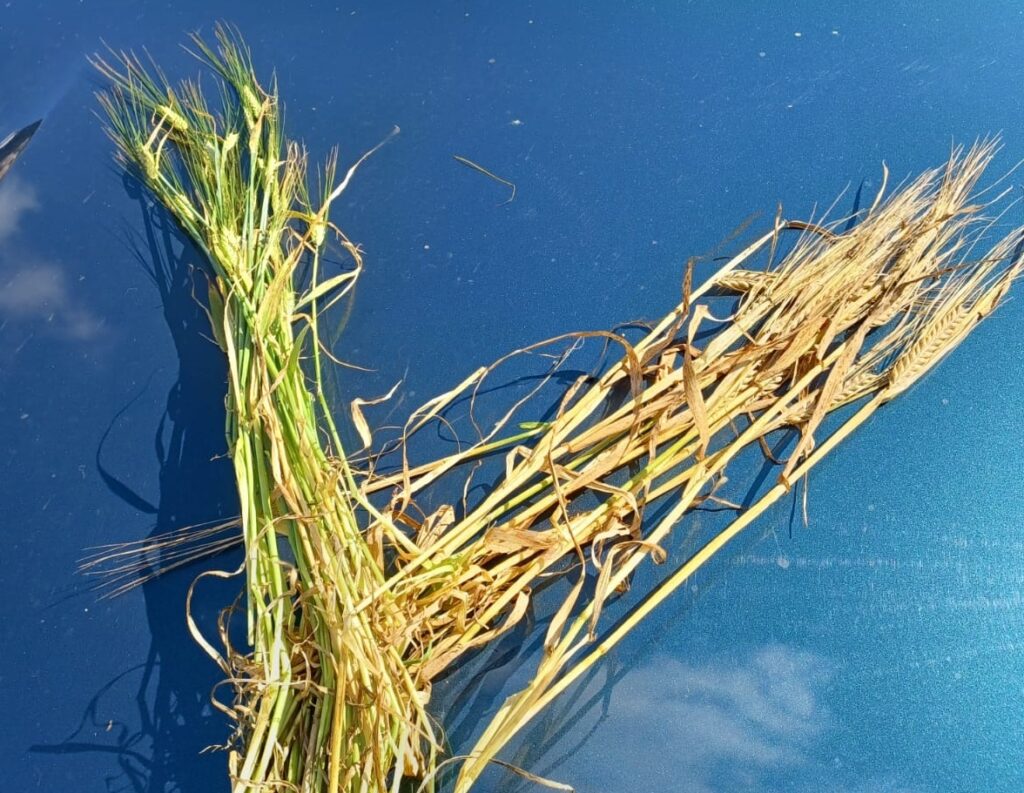Harvesting with uneven ripening in spring barley
14 August 2023Scottish maltsters will be hoping to secure over 94% of this year’s spring barley crop with grain nitrogens below 1.65% and the required high germination, and while last year saw the spring barley harvest go smoothly, this year is shaping up to be very different with secondary tillers now causing a major headache in the run-up to combining.
The dry spell in May and much of June combined with later sowing saw spring barley crops struggle to take up nitrogen. Crops responded by speeding through the growth stages very quickly with many crops reaching T2 a week earlier than normal. The rains in late June and July however meant that crops were provided with a late boost in nutrient availability, with the extra flush of nitrogen resulting in both a surge in growth in some crops and crops putting down more tillers. A month later these new tillers have continued to develop, and we are now seeing crops an uneven mix of dark yellow and green with part of the crop only a couple of weeks away from combining, with the rest several weeks behind.
This has quite significant implications, particularly for growers of malting barley crops who now face a conundrum on a field-by-field basis. While the initial generation of tillers is close to maturity and are on the whole well-filled, the secondary tillers tend to have shorter heads with fewer grains and in many cases have still to fill. When harvested, this mixed crop may have higher nitrogen levels, higher screenings and green grains leading to deductions or rejections where there is a high proportion of secondary tillers. Conversely, should the crop be harvested too late and targeted at the secondary tillers, there is a risk of the first set of grains weathering and suffering from deteriorating germination, again impacting on sample quality or worse, yield is lost as heads end up on the ground.
Due to variability across farms and even within individual fields, this is very much one of those situations whereby growers must assess each field and there may well be no right or wrong answer.
In fields where the percentage of secondary tillers is fairly small and where the heads are short and grains still to fill the decision is simpler, allow the original tillers to ripen and harvest as normal. For those growers considering using glyphosate, this should be applied as normal when the main body of the crop is below 30% moisture although rates may need to be slightly higher than the those usually used for harvest management given the higher amount of green material. Aim for 1000 grams active ingredient/ha. This will also see some of the immature grains shrivel up. The combine driver can also play a key role here by keeping the wind speed up to blow the smaller grains out the back of the combine to try and remove as many of the grains from the secondary tillers as possible from the sample.
In other fields, where secondary tillers can make up around 50% of the crop, the decision is much more difficult. Should harvest be delayed to optimise the overall yield and run the risk of quality issues or should the field be cut or sprayed off early to get the grain from the main tillers at the optimum time with the resultant loss in yield by losing the grain from the secondary tillers. Much will depend on the end market, and for feed barley growers the decision is simpler, especially if it is being retained for home feeding. Once again, if glyphosate is being used, rates may need to be increased from normal pre-harvest application rates. For malting barley growers however, reaching for glyphosate may not be an option depending on their buyer’s terms and gauging the timing of application will be very difficult. The risks of waiting for the secondary tillers to produce big bold grains may also result in the crop brackling as it becomes over-ripe, bringing another set of problems.
No two years are the same, with each year bringing its own set of challenges. In conclusion, taking the time to go through the fields in advance of harvest to assess the level of secondary tillers and whether to bring forward or delay harvest will likely pay dividends. Decide for each field what action will likely optimise both total field yield and appropriate grain quality to achieve the highest financial return.
Sign up to the FAS newsletter
Receive updates on news, events and publications from Scotland’s Farm Advisory Service

